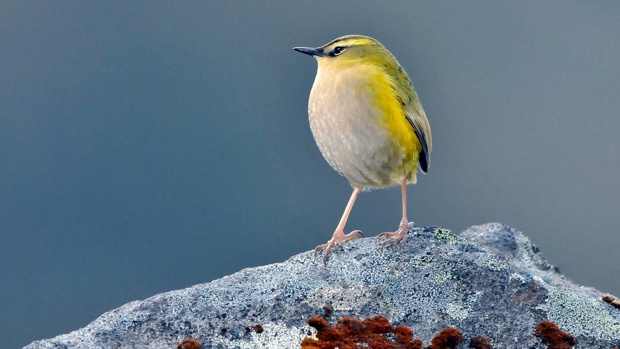The beautiful Rock Wren Pīwauwau has been crowned the Bird of the Year for 2022

The beautiful Rock Wren Pīwauwau won Bird of the Year in 2022. Photo / NZH
The tailless wonder of the south, the rock wren or pīwauwau has been crowned Bird of the year 2022.
Pīwauwau was conferred rock-star status after a two-week public voting period and a hotly contested hustings.
The wren clinched it with 2894 votes but, despite winning top billing, the bird is hardly known to many New Zealanders.
“Unless you’d spent some time in the mountains, you’d probably never heard of a rock wren until two weeks ago,” said Stephen Day, lead campaigner for the pīwauwau and the Outdoor Access Commission.
"It's a true underbird."
They are easily recognisable. The tiny birds’ long legs make them the mountaineers of the bird world and they have natural crampons and snowshoes for navigating high altitudes. Although they are designate as “in serious trouble” ecologically, there are plenty of opportunities to spot the wren in the wild above the scrub line.
Day said a trip to the mountains is your best chance to see the birds.
"It's so worth the trip to see pīwauwau in the Southern Alps. They are tiny birds, chock-full of character, and like so many other species, they're threatened by pests and climate change."
Occupying a habitat from 900m to 2500m above sea level, they are found in pockets throughout the South Island’s higher regions.
 Photo / Sebastian Goldberg, Unsplash
Photo / Sebastian Goldberg, Unsplash
The wren wasn't the only alpine bird that got the backing of New Zealanders.
In third place was the kea, the world’s only mountain parrot, which was just behind the kororā little penguin, a 25cm tall bird that weighs roughly as much as a bag of flour. Controversially, the wren claimed 457 fewer votes than the penguin but took the top perch thanks to the preferential voting system used this year.
The wren’s election to Bird of the Year 2022 wasn’t the only decision to ruffle feathers. At the beginning of the month, Forest and Bird was threatened with legal action if it did not include extinct bird species in the running.
"We need to be urgently reminded of what we have already lost, if we are to minimise further loss," wrote a concerned conservationist, who was lobbying for extinct animals to be on the ballot.
Forest and Bird were told to expect "a class action on behalf of all the extinct birds of New Zealand", if the huia - a bird last seen in the wild in 1907 - was not represented. Legal representatives for the moa are yet to be heard from.
Where to see the Rock Wren or Pīwauwau
Ellen Rykers was thrilled to see that birds from New Zealand's snowy maunga were so well represented in this year's competition.
"The Bird of the Year title not only highlights how adorable and special pīwauwau are but also highlights the need for effective predator control in the places they live – high up in the mountains."

Photo / Supplied, Forest and Bird
Rock wrens are not only battling invasive predators like stoats and rats, but also the threat to habitat from climate change. The insulated birds rely on the snowy alpine ridgelines of New Zealand to survive.
Crossing the Divide to the West Coast and Fiordland is where you'll see the wrens. "Probably the easiest spot to see a rock wren is Homer Tunnel in Fiordland" says Rykers, although she has yet to see one in the wild.
If you want to lend a hand with conservation or up your chance of seeing the tiny birds in person, organisations including the NZ Alpine Club have been helping with trapping and habitat improvement programmes for the pīwauwau.
"People can submit sightings to iNaturalist NZ so we can keep track of where the mini-mountaineers are hanging out."

Photo / Mountain Ash, Unsplash
Fiordland Crossing the divide and in high alpine passes on the Routeburn pass and Milford tracks is top pīwauwau territory. You might even see them along the SH94 on the way to Milford Sound, although populations have been badly affected by mammal predators. There is a healthy population on the predator-free Secretary Island in Fiordland, introduced in 2010.
Mt Aspiring and Mt Cook National Parks The most accessible areas of New Zealand's alpine wilderness to see the pīwauwau include the many day tracks from Mt Cook Village in the Aoraki / Mt Cook National Park.
Arthur's Pass On the pass East to West along SH73 there are plenty of opportunities for day walks and trips into pīwauwau territory. Departing Arthur's Pass Village or the Craigieburn valley you might hear their call.
Nelson Lakes and Kahurangi National Parks The most northerly pockets of pīwauwau can be found in the Nelson Lakes and the boundaries of the West Coast.
The tiny birds, which weigh less than an AA battery, exist in places where only they and the odd mountaineer dare to go. If you’re going birdwatching to look for the rock wren, make sure you check all trail conditions and forecasts first with the Mountain Safety Council and Department of Conservation.
This article was first published on the NZ Herald and is republished here with permission.
Take your Radio, Podcasts and Music with you

